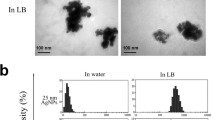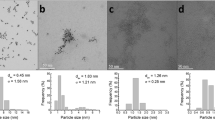Abstract
In this study, we investigated multi-generational effects and generation particle transfer in Caenorhabditis elegans following maternal food exposure to core-shell quantum dots. We found that that the Bag of Worms (BOW) phenotype in aged worms induces changes in quantum dot distribution in the parental body, which is related to the inter-generation transfer of these nanoparticles and to their effects in the offspring. To confirm these results we examined a variety of endpoints, namely, survival, reproduction, aging phenotype, oxidative stress, and intestinal fat metabolism. We show that worms born to parents at different times after exposure show different phenotypic effects as a consequence of quantum dot transfer. This evidence of trans-generational transfer and the effects of nanoparticles highlights the complex multi-generational effects and potential safety hazards that can occur under real environmental conditions.




Similar content being viewed by others
References
American Society for Testing and Materials (2014) Standard guide for conducting laboratory soil toxicity tests with the nematode Caenorhabditis elegans, ASTM E2172–01
Angelo G, Van Gilst MR (2009) Starvation protects germline stem cells and extends reproductive longevity in C. elegans. Science 326:954–958
Arndt DA, Chen J, Moua M, Klaper RD (2014) Multigeneration impacts on Daphnia magna of carbon nanomaterials with differing core structures and functionalizations. Environ Toxicol Chem 33:541–547
Bundschuh M, Seitz F, Rosenfeldt RR, Schulz R (2012) Titanium dioxide nanoparticles increase sensitivity in the next generation of the water flea Daphnia magna. PLoS One 7:e48956
Byerly L, Cassada R, Russell R (1976) The life cycle of the nematode Caenorhabditis elegans: I. wild-type growth and reproduction. Dev Biol 51:23–33
Chen J, Caswell-Chen EP (2003) Why Caenorhabditis elegans adults sacrifice their bodies to progeny. Nematology 5:641–645
Collin B, Oostveen E, Tsyusko OV, Unrine JM (2014) Influence of natural organic matter and surface charge on the toxicity and bioaccumulation of functionalized ceria nanoparticles in Caenorhabditis elegans. Environ Sci Technol 48:1280–1289
Contreras EQ, Cho M, Zhu H, Puppala HL, Escalera G, Zhong W, Colvin VL (2012) Toxicity of quantum dots and cadmium salt to Caenorhabditis elegans after multigenerational exposure. Environ Sci Technol 47:1148–1154
Contreras EQ, Puppala HL, Escalera G, Zhong W, Colvin VL (2014) Size-dependent impacts of silver nanoparticles on the lifespan, fertility, growth, and locomotion of Caenorhabditis elegans. Environ Toxicol Chem 33:2716–2723
Fischer J, Lefèvre C, Morava E, Mussini J-M, Laforêt P, Negre-Salvayre A, Lathrop M, Salvayre R (2007) The gene encoding adipose triglyceride lipase (PNPLA2) is mutated in neutral lipid storage disease with myopathy. Nat Genet 39:28–30
Hoile SP, Lillycrop KA, Thomas NA, Hanson MA, Burdge GC (2011) Dietary protein restriction during F0 pregnancy in rats induces transgenerational changes in the hepatic transcriptome in female offspring. PLoS One 6:e21668
Hsu PCL, O'Callaghan M, Al-Salim N, Hurst MR (2012) Quantum dot nanoparticles affect the reproductive system of Caenorhabditis elegans. Environ Toxicol Chem 31:2366–2374
Hubbard EJA, Greenstein D (2005) Introduction to the germ line, Wormbook, 1–4, https://doi.org/10.1895/wormbook.1.18.1
Hughes SE, Huang C, Kornfeld K (2011) Identification of mutations that delay somatic or reproductive aging of Caenorhabditis elegans. Genetics 189:341–356
Jacobasch C, Völker C, Giebner S, Völker J, Alsenz H, Potouridis T, Heidenreich H, Kayser G, Oehlmann J, Oetken M (2014) Long-term effects of nanoscaled titanium dioxide on the cladoceran Daphnia magna over six generations. Environ Pollut 186:180–186
Khare P, Sonane M, Nagar Y, Moin N, Ali S, Gupta KC, Satish A (2015) Size dependent toxicity of zinc oxide nano-particles in soil nematode Caenorhabditis elegans. Nanotoxicology 9:423–432
Khatchadourian A, Maysinger D (2009) Lipid droplets: their role in nanoparticle-induced oxidative stress. Mol Pharm 6:1125–1137
Kim SW, Nam S-H, An Y-J (2012) Interaction of silver nanoparticles with biological surfaces of Caenorhabditis elegans. Ecotoxicol Environ Safe 77:64–70
Kim SW, Kwak JI, An Y-J (2013) Multigenerational study of gold nanoparticles in Caenorhabditis elegans: Transgenerational effect of maternal exposure. Environ Sci Technol 47:5393–5399
Kumar AK, Pandey SS, Singh R, Shanker A, Dhawan A (2011a) Cellular uptake and mutagenic potential of metal oxide nanoparticles in bacterial cells. Chemosphere 83:1124–1132
Kumar AK, Pandey SS, Singh R, Shanker A, Dhawan A (2011b) A flow cytometric method to assess nanoparticle uptake in bacteria. Cytometry Part A 79:707–712
Kuo Y, Hsu T-Y, Wu Y-C, Chang H-C (2013) Fluorescent nanodiamond as a probe for the intercellular transport of proteins in vivo. Biomaterials 34:8352–8360
Luo S, Murphy CT (2011) Caenorhabditis elegans reproductive aging: regulation and underlying mechanisms. Genesis 49:53–65
Meyer JN, Lord CA, Yang XY, Turner EA, Badireddy AR, Marinakos SM, Chilkoti A, Wiesner MR, Auffan M (2010) Intracellular uptake and associated toxicity of silver nanoparticles in Caenorhabditis elegans. Aqua Toxicol 100:140–150
Mohan N, Chen C-S, Hsieh H-H, Wu Y-C, Chang H-C (2010) In vivo imaging and toxicity assessments of fluorescent nanodiamonds in Caenorhabditis elegans. Nano Lett 10:3692–3699
Mosser T, Matic I, Leroy M (2011) Bacterium-induced internal egg hatching frequency is predictive of life span in Caenorhabditis elegans populations. Appl Environ Microbiol 77:8189–8192
Panacek A, Prucek R, Safarova D, Dittrich M, Richtrova J, Benickova K, Zboril R, Kvitek L (2011) Acute and chronic toxicity effects of silver nanoparticles (NPs) on Drosophila melanogaster. Environ Sci Technol 45:4974–4979
Pluskota A, Horzowski E, Bossinger O, von Mikecz A (2009) In Caenorhabditis elegans nanoparticle-bio-interactions become transparent: silica-nanoparticles induce reproductive senescence. PLoS One 4:e6622
Qu Y, Li W, Zhou Y, Liu X, Zhang L, Wang L, Li Y-F, Iida A, Tang Z, Zhao Y (2011) Full assessment of fate and physiological behavior of quantum dots utilizing Caenorhabditis elegans as a model organism. Nano Lett 11:3174–3183
Scharf A, Piechulek A, von Mikecz A (2013) Effect of nanoparticles on the biochemical and behavioral aging phenotype of the nematode Caenorhabditis elegans. ACS Nano 7:10695–10703
Szewczyk NJ, Udranszky IA, Kozak E, Sunga J, Kim SK, Jacobson LA, Conley CA (2006) Delayed development and lifespan extension as features of metabolic lifestyle alteration in C. elegans under dietary restriction. J Exp Biol 209:4129–4139
Tissenbaum HA, Ruvkun G (1998) An insulin-like signaling pathway affects both longevity and reproduction in Caenorhabditis elegans. Genetics 148:703–717
Torrens C, Poston L, Hanson MA (2008) Transmission of raised blood pressure and endothelial dysfunction to the F2 generation induced by maternal protein restriction in the F0, in the absence of dietary challenge in the F1 generation. Br J Nutr 100:760–766
Trent C, Tsung N, Horvitz HR (1983) Egg-laying defective mutants of the nematode Caenorhabditis elegans. Genetics 104:619–647
Völker C, Boedicker C, Daubenthaler J, Oetken M, Oehlmann J (2013) Comparative toxicity assessment of nanosilver on three Daphnia species in acute, chronic and multi-generation experiments. PLoS One 8:e75026
Wang MC, O'Rourke EJ, Ruvkun G (2008) Fat metabolism links germline stem cells and longevity in C. elegans. Science 322:957–960
Wang Q, Ebbs SD, Chen Y, Ma X (2013) Trans-generational impact of cerium oxide nanoparticles on tomato plants. Metallomics 5:753–759
Zhang SO, Box AC, Xu N, Men JL, Yu J, Guo F, Trimble R, Mak HY (2010) Genetic and dietary regulation of lipid droplet expansion in Caenorhabditis elegans. Proc Natl Acad Sci 107:4640–4645
Acknowledgements
We thank Prof. Yhong Hee Shim (Konkuk University) and Prof. Junho Lee (Seoul National University) for providing the C. elegans strains.
Funding
This research was supported by the National Research Foundation of Korea (NRF) funded by the Ministry of Science, ICT, and Future Planning (2016R1A2B3010445, 2016M3A6A7945504). This work also was supported by Korea Environment Industry & Technology Institute through “The Chemical Accident Prevention Technology Development Project”, funded by Korea Ministry of Environment (No. 2016001970001).
Author information
Authors and Affiliations
Corresponding author
Additional information
Responsible editor: Philippe Garrigues
Electronic supplementary material
ESM 1
(DOCX 1080 kb)
Rights and permissions
About this article
Cite this article
Kim, S.W., Moon, J. & An, YJ. Matricidal hatching can induce multi-generational effects in nematode Caenorhabditis elegans after dietary exposure to nanoparticles. Environ Sci Pollut Res 25, 36394–36402 (2018). https://doi.org/10.1007/s11356-018-3535-4
Received:
Accepted:
Published:
Issue Date:
DOI: https://doi.org/10.1007/s11356-018-3535-4




